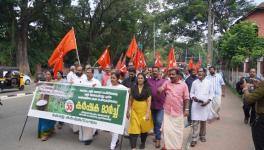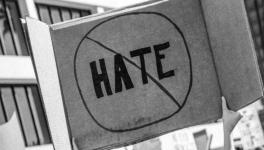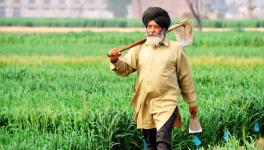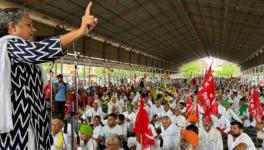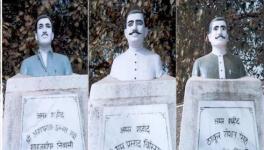Communists and India’s Freedom Struggle
At the turn of the twentieth century, Lenin declared that ‘no matter which turn history takes, but we shall not allow history to take any turn without our participation’. Communists worldwide took the dictum seriously by participating in class and anti-colonial nationalist struggles. India’s struggle for freedom was no exception.
The Indian communist movement is more than a century old. It was forged in the crucible of anti-colonial nationalism. The First World War had wrecked the world and exposed that the garrulousness of the capitalist-imperial powers knew no limits. Human slaughter of millions was merrily acceptable at the altar of profits and territorial expansionism. The political response of the oppressed came in the form of the establishment of the Communist International (Comintern) in March 1919 under the leadership of Lenin. The founding of the Comintern marked the tripartite differentiation of the international socialist movement.
First were the social-chauvinists who supported their own national bourgeoisie in the slaughter of the First World War; secondly, the likes of Kautsky and his followers who kept vacillating between treachery and opportunism; and finally, the revolutionary left-wing whose agenda was international socialist revolution. The Comintern was incubated in the latter’s laboratory.
One of the first and foremost questions taken up by the Comintern was that of the colonies. The first manifesto of the Comintern, titled Manifesto of the Communist International to the Workers of the World, prepared by Leon Trotsky, linked the fight of the peasants and workers colonies with that of the West. It heralded an internationalism hitherto unheard of. It declared,
“The emancipation of the colonies is conceivable only in conjunction with the emancipation of the working class in the metropolises. The workers and peasants not only of Annam, Algiers, and Bengal but also of Persia and Armenia; will gain their opportunity of independent existence only in that hour when the workers of England and France, having overthrown Lloyd George and Clemenceau, will have taken state power into their own hands.”
In a genuine bid to offer help to the colonies, the manifesto also declared, ‘‘if capitalist Europe has violently dragged the most backward sections of the world into the whirlpool of capitalist relations, then socialist Europe will come to the aid of liberated colonies with her technology, her organisation and her ideological influence in order to facilitate their transition to a planned and organised socialist economy.’’
On the eve of the second Congress of the Comintern, Lenin prepared a preliminary draft resolution on the ‘National Question in Colonies’. The tactical gist of the draft was that the Comintern and the communist parties in the colonies should support the national liberation movements in conjunction with the bourgeois democratic parties. M.N Roy alias Narendranath Bhattacharya, an Indian revolutionary, was then present as a delegate. Roy objected to Lenin’s formulation because the native bourgeoisie of the colonies had accumulated a lot of capital in their hands and aimed to use the huge natural resources of their countries to establish the rule of ‘capital’ over the working masses. Although Lenin took exception to the argument, Roy’s thesis resulted in an amendment to the former’s draft. Support for ‘revolutionary liberation movements’ was substituted for ‘bourgeois democratic movements’.
However, the term ‘revolutionary’ was given a very moderate meaning by Lenin. It would apply wherever the bourgeois nationalists ‘did not hinder us (the communists) in training and organising the peasants and broad masses of the exploited in a revolutionary spirit’. The question here is not whether Lenin’s argument was proved correct by the forces of history or Roy’s objections carried a weight of their own. What is important here is that in a victorious revolutionary setting, we have Lenin, the greatest revolutionary of the international working class, rubbing shoulders with an Indian and accommodating the latter’s arguments on a crucial issue.
Compare this to the liberal messiah of the age—Woodrow Wilson’s demeanour when he declined to meet a young Vietnamese who had come to meet him to plead for the case of his people against French imperialism. The man was the great Ho Chi Minh, who then turned to Lenin and communism for deliverance against imperialism.
Roy’s influential presence at the nerve centre of the world communist movement meant that for the first time in history, voices from the colonies were given a place of importance to intervene in matters of historical significance and, more importantly, to make and shape their own destiny. Roy’s intervention also marked the activation of the radical agency of the colonised, which till the nineteenth century, as was seen in the case of the Brahmo cosmopolitanism in India, was busy debating whether the Bible was an Asian book or whether Jesus was Asia’s first spiritual export to Europe. Roy’s participation marked the continuation of communist cosmopolitanism, which started with Karl Marx and continued till Che Guevara’s martyrdom.
The commitment of the early Bolsheviks to the cause of the anti-colonial movements could be gauged by recalling a fact that is significantly less known even within the Marxist revolutionary circles. When the revolutionary tide had ebbed in the Western countries, especially in Germany, Leon Trotsky, then the head of the Red Army, had cabled Lenin on August 6, 1919, asking him to bypass the lengthy interval of the European revolution by intervening directly in Asia. Marked as 'Top Secret', the letter declared:
“The road to India may prove at the given moment to be more readably passable and shorter for us than the road to Soviet Hungary. The sort of army which at the moment can be of no great significance on the European scales can upset the unstable balance of Asian relationships of colonial dependence, give a direct push to an uprising on the part of the oppressed masses and assure the triumph of such a rising in Asia.”
One can just imagine what would have happened if the Red Army had militarily intervened in India in the aftermath of the Jallianwala Bagh tragedy and on the eve of the Non-Cooperation Movement. British imperialism might have died a painful death. And if not a painful death, at least the Raj would have suffered irreparable damage, and India would have been spared the horrors of partition, which was overseen and, in a way, engineered by the Raj’s criminal haste.
II
The Communist Party of India was formed in Tashkent on October 17, 1920. The nucleus mainly consisted of Indian political emigres who were, in the first place, keen to fight for the Caliphate in Turkey but later came over to communism after facing the unexpected wrath of their co-religionists in Central Asia. Such developments in the North caused considerable consternation to the British. Intelligence reports about a possible communist infiltration led the British imperial government in India to pass the Passport Act, 1920. It aimed to ‘screen elements’ entering or leaving India, with particular attention paid to ‘keeping undesirable aliens’ out of India. Later on, the open seas became the point of contact between communism and India.
The increasing fear of the Indian Seamen Association, with collaboration from communists in Britain and France, entering India with 'subversive propaganda' (mostly communist publications) led to the Sea Customs Act of 1932, which gave increased powers to colonial officials to prosecute any individual found to be guilty of using the sea routes to promote anti-government activities in India.
The newborn Communist Party of India actively started to send communists into India. The then chief of the British Intelligence Bureau, David Petrie cautioned against judging the threat of communism based purely on the low membership in communist organisations. He further added, ‘the ease with which popular feeling against the (British imperial) Government can be whipped up in this country, will ever tend to increase the odds in favour of communism being able to find its opportunity’. Clearly, within a year of its formation, the communist party, albeit small and in exile, became a source of threat for the mighty British empire.
The first attack on the communists came in the form of the Peshawar Conspiracy Case (1921-23). Muhammad Akbar Khan, a 26-year-old man, who probably served in the Red Army, was apprehended by the British and sentenced to seven years of rigorous imprisonment.
During the crucial Ahmedabad session of the Indian National Congress in 1921, the Manifesto of the Communist Party of India was read out. It declared,
“If the Congress would lead the revolution, which is shaking India to the very foundation, let it not put faith in mere demonstrations and temporary wild enthusiasm. Let it make the immediate demands of the trade unions its own demands; let it make the programme of the Kisan Sabhas its own programme, and the time will soon come when the Congress will not stop before any obstacle; it will be backed by the irresistible strength of the entire population consciously fighting for their material interests.”
It was at the Ahmedabad session that early enthusiasts of the Communist Party of India Maulana Hasrat Mohani and Swami Kumarananda tabled a resolution before the Congress that spoke of complete independence from British rule. It was Gandhi who struck hard in opposition and said, ‘it has grieved me because it shows lack of responsibility’, securing the resolution’s rejection. It must be remembered that Congress adopted complete independence from the British - 'Poorna Swaraj' resolution only eight years later, in December 1929.
III
The end of the First World War, along with the massive popular waves of the Non-Cooperation Movement, brought forth the question of organised labour as a potential anti-imperialist force. The Madras Labour Union was founded in 1918. Its leader M Singaravelu, who later became a senior leader of the Communist Party, celebrated the first ever May Day in India in 1923. It is said that in the absence of a red flag in Comrade Singaravelu’s house, he prepared one by tearing off one of his daughter’s red saree and hoisting it atop his house.
Similarly, Muzaffar Ahmad in Calcutta, S.A Dange in Bombay, and Ghulam Hussein in Lahore, all of whom went on to become senior leaders of the communist party, started organising labour and spreading communist ideas in their respective cities. However, the work was cut short as most of the leaders were arrested in the Kanpur Bolshevik Conspiracy Case 1924. The charge that was brought against them was ‘to deprive the King Emperor of his sovereignty of British India, by complete separation of India from imperialistic Britain by a violent revolution’.
Despite the case, a defiant meeting of communists was held openly in Kanpur in December 1925. The definition of the Party’s objectives was stated as ‘the establishment of a workers’ and peasants’ republic based on the socialisation of the means of production and distribution, by the liberation of India from British imperialist domination’. Furthermore, in a significant statement on the declaration form, it was added that ‘no one who is a member of any communal organisation shall be admitted as a member of the Communist Party’. This made the Communist Party of India, perhaps, the first political party of any significance to exclude persons belonging to communal organisations.
In the absence of a proper all-India platform, communists organised the Workers’ and Peasant Party (WPP) in 1928. It took inspiration from the Peasants’ and Workers’ Party of Bengal. The Party in the first year of its foundation, had called for ‘complete independence based on economic and social emancipation’. It also played a crucial role in organising protests against the incarceration of Subhash Chandra Bose in Mandalay jail. The WPP’s best show of strength happened on December 30, 1928, when 20,000 industrial workers marched into the place where the annual session of Congress was being held.
The march was a protest against the report prepared by Motilal Nehru, famously called the ‘Nehru Report’ that recommended dominion status as the political aim of Congress. The workers occupied the place for two hours and demanded that the Congress party accept complete independence as its goal. Later on, Nehru presided over the Socialist Youth Congress session at which communism was declared ‘as the only way out’.
As the labour movement picked up steam, the strike movement in 1928 totalled 31 million working days which was more than the previous five years put together. The Bombay textile strike, which lasted for six months wherein a labour force of 150,000 workers stood united, was one of the most glorious centrepieces of working-class struggle.
The measure of worker’s enthusiasm could well be gauged from the fact that the Girni Kamgar Union (Red Flag) of the Bombay mill workers started with a membership of a paltry 324 members and by December 1928 had reached a mammoth 54,000! Such was the political strength of the communists in Bombay that the police commissioner of the city noted in 1929 that ‘the Congress Party would not have been able to stage any demonstration in Bombay against the Simon Commission’. The British government’s Annual Report of 1928-29 recorded that ‘the growth of communist propaganda and influence especially among the industrial classes of large towns has caused anxiety to the authorities’. The Bombay Chronicle in May 1929 proclaimed that ‘socialism is in the air’.
The imperial government turned its full offensive to counter the rise of the working-class movement. It passed the Public Safety Bill as a special ordinance to ‘curb communist activities in India’. It must be remembered that it was against the same Public Safety Bill and the Industrial Disputes Bill that Bhagat Singh and Batukeshwar Dutt threw bombs in the central legislative assembly and roaringly declared during their trial ‘if the deaf are to hear, the sound has to be very loud’.
Left-leaning leaders such as Jawaharlal Nehru also expressed deep sympathies with the labour movement. A significant development that has received scant attention from mainstream historians was that at midnight before the year turned 1930, the flag of Indian independence was unfurled. The first flag was red, white, and green, the red symbolising the stamp of socialism. Later on, red was substituted by saffron.
As the nation celebrated Independence Day on January 26 1930, demonstrators in Bombay made an effort to hoist the red flag alongside the tricolour. The left congressmen rejoiced at this whilst the right was horrified. Nehru clarified that there is and should be no rivalry between the tricolour flag and the workers’ red flag. Nehru said that he honours and respects the red flag because it represents the blood and sufferings of the workers.
Nehru remained in awe of the international communist movement. In his book Discovery of India, he veneratingly wrote of Lenin,
“In Central Asia, even today, four legendary figures of great conquerors are remembered—Sikander (Alexander), Sultan Mahmud, Chengiz Khan and Timur. To these four must be added now a fifth, another type of person, not a warrior, but a conqueror in a different realm, round whose name legend has already gathered — Lenin.”
IV
The crackdown on the communist threat took its most decisive form in the Meerut Conspiracy Case 1929. All the principal leaders of the working-class movement were arrested from all over India and brought to Meerut for trial. Thirty-two people were put on trial, which included three English communists, Philip Spratt, Ben Bradley, and H.L Hutchinson. When three Englishmen went to imperial jails, it showcased a historic demonstration of organic international and anti-imperial working-class solidarity. The Meerut trial became the most expensive and long-drawn trial in the history of British imperialism.
British intelligence agents used evidence collected in the Meerut trial to launch an offensive against international communist activities not only in India, where the Communist Party of India was banned in 1934 but also in Southeast Asia and the Far East.
Despite the setback of Meerut, the ember of revolutionary socialism was kept alive by Bhagat Singh and his comrades. The change of the name of the revolutionary organisation Hindustan Republican Association (HRA) to Hindustan Socialist Republican Association (HSRA) clearly hinted at a qualitative shift in the politics of the revolutionaries.
It was Bhagat Singh who proposed the amendment and carried it forward. ‘‘This change of name was not ornamental,” says the famous Bhagat Singh historian Prof. Chaman Lal. He argues that unlike Indira Gandhi, who added ‘socialist’ to the Preamble of the Constitution, for Bhagat Singh and his comrades, “it was a well thought out qualitative change of perception about the goal of the Indian revolution’’.
In his last essay, 'An Appeal to the Young Political Workers’, written on February 2, 1931, Bhagat Singh urged the young people to read Marx and Lenin and undertake mass propaganda and elucidated the meaning of revolution as freedom from the bondage of capitalism and imperialist wars. In the same essay, Bhagat Singh wrote,
“You cry, ‘Long Live Revolution’. Let me assume that you really mean it. According to our definition of the term, as stated in our statement in the Assembly Bomb Case, revolution means the complete overthrow of the existing social order and its replacement with the socialist order. For that purpose, our immediate aim is the achievement of power. As a matter of fact, the state, and the government machinery is just a weapon in the hands of the ruling class to further and safeguard its interest. We want to snatch and handle it to utilise it for the consummation of our ideal, i.e., social reconstruction on a new, i.e., Marxist, basis.”
One of Bhagat Singh’s younger comrades, Ajoy Ghosh, who was in jail with him and later went on to become the General Secretary of the Communist Party of India, wrote in his essay Bhagat Singh and his Comrades,
“We felt sympathetic to the communists and, at one time, even contemplated some sort of a working alliance with them to organise masses and conduct the mass movement. We of the Hindustan Socialist Republican Association (HSRA) planned to work as its armed section. But when we learned that the communists considered armed action by individuals to be harmful to the movement, we dropped the idea.”
After the hanging of Bhagat Singh, Sukhdev, and Rajguru and the end of the revolutionary movement, a lot of young revolutionaries went towards communism and joined the Communist Party of India. Some of the prominent names were Kalpana Dutta, who was involved in the heroic Chittagong armoury raid under the stewardship of Master Da Surya Sen, Dhanwantri, Ganesh Ghosh, Anant Singh, and Shiv Verma.
Even within the Congress, especially after the Civil Disobedience Movement, left-wing and socialist ideas consummated and led to the establishment of the Congress Socialist Party (CSP) in 1934. Ajoy Ghosh and P Sudarayya were already working within the CSP. The famous Dutt-Bradley thesis of 1936 that called on the communists to coalesce in a united front with the Congress against British imperialism allowed for a more effectual entry of communists into the Congress.
For instance, EMS Namboodiripad was at first a member of the CSP, and whilst he became the secretary of the Kerala Pradesh Congress Committee, he had already transformed into a communist. And it was during this period that the socialists and communists in Kerala led workers, peasants, and the temple entry movement of the lower castes.
The All-India Kisan Congress (later on Sabha) and the Progressive Writer’s Association were formed. The membership of the Kisan Sabha expanded to around 9 million in 1938 from 2.4 million in 1936. The first session of the Progressive Writer’s Association was held in Lucknow and was inaugurated by the legendary Hindi-Urdu writer Munshi Premchand. Many communist writers such as Sajjad Zaheer, Faiz Ahmad Faiz, Mulk Raj Anand, Hasrat Mohani, and Hiren Mukherjee were its founding members. It is pertinent here to recall the impact of the Bolshevik Revolution on stellar Indian authors. Within a few months of the Revolution, Premchand made a pointed reference to it in one of his novels Premashrama (1919), where one of his young peasant characters, Balraj, says to a group of peasants,
“...you laugh as though the peasant does not count and is born only to labour on the land of the landlord. But the newspapers tell me that in Russia, the peasants’ rule and they do what they like. The peasants there recently dethroned the king and now there is a 'Panchayat' Raj of peasants and workers in that country.”
V
From 1940 till independence, when the twin evils of global fascism and communalism racked the world and Indian politics, and most of the national leadership of the Congress was behind bars, the communist party led the working class and organised strikes in Ahmedabad and Jamshedpur. The Trade Union Congress, led by communists, gave a call to observe September 25, 1942, as Anti-Repression Day. The work of communists during the Bengal famine, a handiwork of Churchill and his coterie caused by the deliberate diversion of food grain for the war effort, was also commendable.
The Communist Party of India organised hunger marches against grain hoarding, opened ration shops, and organised community kitchens that distributed milk for hungry children. In the Rajshahi division, the party organised Krishak samitis to demand the suspension of repayment of agricultural loans. In Calcutta, the communists organised a huge demonstration before the Legislative Assembly, where some thousands of women converged with the demand for rice. Women and students formed the bedrock of the communist movement during this period. In Bengal alone, the number of students affiliated with the communist-controlled All-India Student Federation was 20,815, whereas the Women’s Self-Defence Committee alone consisted of 23,480 members. Communist Party’s many-sided activities during this crucial period, despite heavy odds, led to an exponential growth in party membership. Starting with a bare 4,000 in July 1942, it had jumped to 15,000 by May 1943 and over 53,000 by the summer of 1946.
On the eve of independence, when communal riots assumed menacing proportions, communists, in both personal and political capacities, helped the victims of riots and organised relief camps.
To conclude, it is the most gruesome irony of history that on the seventy-fifth anniversary of India’s independence, religious communalism, which marked the twilight of India's independence, has raised its ugly head again. Communists have their task cut out to defeat this hydra-headed monster before it devours India, for whose freedom generations of communists laid down their lives.
The writer is a research scholar with the Department of World History, University of Cambridge. The views are personal
Get the latest reports & analysis with people's perspective on Protests, movements & deep analytical videos, discussions of the current affairs in your Telegram app. Subscribe to NewsClick's Telegram channel & get Real-Time updates on stories, as they get published on our website.











